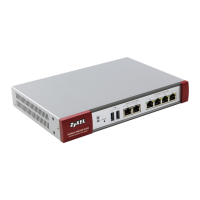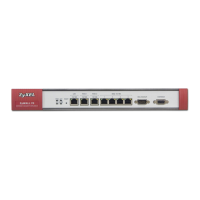USG20(W)-VPN Series User’s Guide
101
CHAPTER 6
Monitor
6.1 Overview
Use the Monitor screens to check status and statistics information.
6.1.1 What You Can Do in this Chapter
Use the Monitor screens for the following.
•Use the System Status > Port Statistics screen (see Section 6.2 on page 102) to look at
packet statistics for each physical port.
•Use the System Status > Port Statistics > Graph View screen (see Section 6.2 on page 102)
to look at a line graph of packet statistics for each physical port.
•Use the System Status > Interface Status screen (Section 6.3 on page 104) to see all of the
USG’s interfaces and their packet statistics.
•Use the System Status > Traffic Statistics screen (see Section 6.4 on page 106) to start or
stop data collection and view statistics.
•Use the System Status > Session Monitor screen (see Section 6.5 on page 109) to view
sessions by user or service.
•Use the System Status > IGMP Statistics screen (see Section 6.6 on page 110) to view
multicasting details.
•Use the System Status > DDNS Status screen (see Section 6.7 on page 111) to view the
status of the USG’s DDNS domain names.
•Use the System Status > IP/MAC Binding screen (Section 6.8 on page 112) to view a list of
devices that have received an IP address from USG interfaces with IP/MAC binding enabled.
•Use the System Status > Login Users screen (Section 6.9 on page 112) to look at a list of the
users currently logged into the USG.
•Use the System Status > Cellular Status screen (Section 6.10 on page 113) to check your
mobile broadband connection status.
•Use the System Status > UPnP Port Status screen (see Section 6.11 on page 115) to look at
a list of the NAT port mapping rules that UPnP creates on the USG.
•Use the System Status > USB Storage screen (Section 6.12 on page 116) to view information
about a connected USB storage device.
•Use the System Status > Ethernet Neighbor screen (Section 6.13 on page 117) to view and
manage the USG’s neighboring devices via Layer Link Discovery Protocol (LLDP).
•Use the Wireless > AP Information screen (Section 6.14.1 on page 118) to view information
on connected APs.
•Use the Wireless > Station Info screen (Section 6.14.3 on page 121) to view information on
connected wireless stations.
•Use the Wireless > Detected Device screen (Section 6.14.3 on page 121) to view information
about suspected rogue APs.

